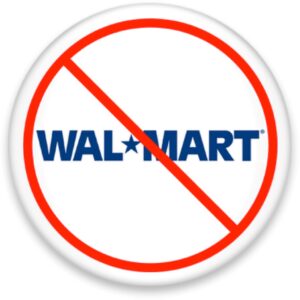 Dumbstruck. That’s how I felt after reading Jeffrey Goldberg’s article in the April 2nd edition of The New Yorker entitled “Selling Wal-Mart.”
Dumbstruck. That’s how I felt after reading Jeffrey Goldberg’s article in the April 2nd edition of The New Yorker entitled “Selling Wal-Mart.”
“The Edelman team assigned to Wal-Mart, I learned, is divided into three groups: ‘promote,’ ‘response,’ and ‘pressure.’ The Jobs and Opportunity Zones notion came from the promotions team. The response-team members – veterans of political campaigns – are supposed to quickly counter criticism in the press or on the Web. The pressure group works on opposition research, focussing on the unions and the press,” Goldberg wrote.
Goldberg did not have to sort through garbage cans to find this information out. No, he was invited to Wal-Mart’s headquarters in Bentonville, Arkansas, where he saw for himself the nerve center of the company’s public relations effort, otherwise known as “Action Alley.” He spoke to Wal-Mart and Edelman executives, most of whom, at best, come off as shallow suits intent on protecting Wal-Mart’s image and their paychecks.
“What on earth was Wal-Mart thinking? What are they paying Edelman all that money for?” a public relations executive at a major retailer told me via email. “Talk about hubris. These guys are setting themselves up for a fall.”
Reading Goldberg’s article, I kept asking myself, why did Wal-Mart and Edelman agree to this? What was the point of inviting in a reporter for one of the most respected publications in the world and then showing off just how smarmy you are? The article, which is framed around Wal-Mart trying to co-opt liberals to its cause, instead shows how the company’s public relations sausage is made.
“The job of the Edelman people – there are about twenty, along with more than three dozen in-house public-relations specialists – is to help Wal-Mart scrub its muddied image. Edelman specializes in helping industries with image problems; another important client is the American Petroleum Institute, a Washington lobbying group that seeks to convince Americans that oil companies care about the environment and that their profits are reasonable. Edelman does its work by cultivating contacts among the country’s opinion elites, with whom it emphasizes the good news and spins the bad; by such tactics as establishing ‘AstroTurf’ groups, seemingly grass-roots organizations that are actually fronts for industry; and, as I deduced from my own visit to Bentonville, by advising corporate executives on how to speak like risk-averse politicians,” wrote Goldberg.
For a company so worried about its image, Wal-Mart certainly did not do itself any favors by giving Goldberg access to its people or facilities. Instead, as with most of Wal-Mart’s attempts at winning public relations points, the effort backfired, something that bemuses a public relations executive at a consumer products maker whose goods are sold in Wal-Mart’s stores.
“You have to understand, these people live in a bubble,” the PR executive told me. “They view everything through a certain prism, one that doesn’t reflect too many colors, and one that refracts light in the wrong direction.”
The wrong direction in this case was Wal-Mart’s willing attempt at transparency.
“I keep that [article] there to remind me never to trust reporters,” a Wal-Mart public relations executive told Goldberg.
Why on earth would anyone in the PR business ever say that to a reporter? That’s not the type of comment that creates a positive atmosphere. Instead, it just muddies the water and causes the reporter to be even more cynical.
Here’s the thing that’s important to remember about Goldberg’s article: It doesn’t matter whether it is unfairly critical (as some have suggested) of Wal-Mart. The company opened its doors to a reporter and in the process should have had total control of the situation. Instead, it was ill-prepared and the public relations people did not stay on message.
Wal-Mart’s attempt to co-opt the liberal media in an effort to reach out to liberals blew up in its face. The company and its Edelman cohorts continue to show an enormous amount of disdain for the public, and in doing so, Wal-Mart continually risks alienating its consumers. The impact, of course, may be negligible, as Wal-Mart’s scale may buffer the company from the ramifications of even the most negative press.
Regardless, Wal-Mart should be a shining light for not just consumers, but business professionals. This is something that General Electric understands, as its executive training program is widely regarded as a better education than one any business school in the world can provide.
The more I hear from Wal-Mart’s public relations people, however, the more I come to realize that the best of course of action is a simple one: Whatever Wal-Mart does, do the opposite. Your chances of winning the public relations war increase exponentially.
This article, written by Ben Silverman, originally appeared in PR Fuel (https://www.ereleases.com/prfuel), a free weekly newsletter from eReleases (https://www.ereleases.com), the online leader in affordable press release distribution. To subscribe to PR Fuel, visit: https://www.ereleases.com/prfuel/subscribe/.
